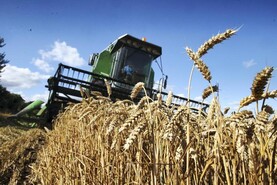At last, we have a clear measure of the environmental impact of relevant biotechnology.
Over the last number of years, Teagasc to its credit, has been looking at the possible place of a GM potato engineered for late blight resistance. The results of a full three years of crop production and analysis are summarised in Teagasc’s excellent latest “Research Impact Highlights” publication. While the trials were being done, Teagasc came under pressure to suspend them and the plots themselves were subject to threats of sabotage and destruction. Teagasc stuck with the trials and the results are now crystal clear.
Conventional potato-growing normally needs more than 12 fungicide sprays per season to control the blight that gave us the potato famine. This spraying programme is by far the main contributor to the environmental effect of conventional potato growing being measured as having over 700 environmental impact points. The GM-engineered potato – the so-called cisgenic variety – had less than 10 environment impact points, just over 1% of the conventional. It is incredible given the hugely beneficial environmental impact of the genetic engineered change involving the introduction of no genetic material from a non-related species that the objections to the technology can be so deep-rooted and intransigent. Coupled with this beneficial environmental effect, there was no significant difference in yield from the cisgenic variety and the control variety which had received a weekly fungicide application. We desperately need similar new solutions in cereals. A similar genetic engineering for septoria would have enormous benefits.
With Monsanto as a brand name now disappearing as a result of the Bayer takeover and an Irish man Liam Condon in charge of agriculture in the new entity, hopefully we will see a reappraisal of what is in both agriculture’s and the environment’s interest.
Last week, I may have been too simplistic in saying that the key productive traits in the beef cattle genome had been fully worked out. While this is true to some extent, it is still some way from commercial reality in forecasting an individual animal’s potential though it is still a worthwhile objective.
Read more
Home Farm: the best hay and cracked ground
At last, we have a clear measure of the environmental impact of relevant biotechnology.
Over the last number of years, Teagasc to its credit, has been looking at the possible place of a GM potato engineered for late blight resistance. The results of a full three years of crop production and analysis are summarised in Teagasc’s excellent latest “Research Impact Highlights” publication. While the trials were being done, Teagasc came under pressure to suspend them and the plots themselves were subject to threats of sabotage and destruction. Teagasc stuck with the trials and the results are now crystal clear.
Conventional potato-growing normally needs more than 12 fungicide sprays per season to control the blight that gave us the potato famine. This spraying programme is by far the main contributor to the environmental effect of conventional potato growing being measured as having over 700 environmental impact points. The GM-engineered potato – the so-called cisgenic variety – had less than 10 environment impact points, just over 1% of the conventional. It is incredible given the hugely beneficial environmental impact of the genetic engineered change involving the introduction of no genetic material from a non-related species that the objections to the technology can be so deep-rooted and intransigent. Coupled with this beneficial environmental effect, there was no significant difference in yield from the cisgenic variety and the control variety which had received a weekly fungicide application. We desperately need similar new solutions in cereals. A similar genetic engineering for septoria would have enormous benefits.
With Monsanto as a brand name now disappearing as a result of the Bayer takeover and an Irish man Liam Condon in charge of agriculture in the new entity, hopefully we will see a reappraisal of what is in both agriculture’s and the environment’s interest.
Last week, I may have been too simplistic in saying that the key productive traits in the beef cattle genome had been fully worked out. While this is true to some extent, it is still some way from commercial reality in forecasting an individual animal’s potential though it is still a worthwhile objective.
Read more
Home Farm: the best hay and cracked ground






 This is a subscriber-only article
This is a subscriber-only article










SHARING OPTIONS: